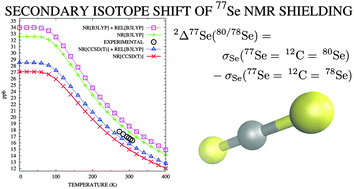Electron correlation and relativistic effects in the secondary NMR isotope shifts of CSe2†
Abstract
Secondary isotope effects on nuclear shielding provide an experimentally well-defined reference point of quantum-chemical methodology. We carry out a quantum-mechanical treatment of thermal rovibrational motion in the linear CSe2 molecule and combine it with relativistic modeling of 77Se and 13C nuclear magnetic shieldings. The effects of electron correlation are studied at nonrelativistic (NR) ab initio and both NR and relativistic density functional theory (DFT) levels. Fully relativistic 4-component Dirac-DFT (D-DFT) as well as Breit–Pauli perturbation theory (BPPT) are used to produce the relativistic shielding surfaces. Quantitative agreement with the experimental secondary isotope effects can be obtained by a piecewise combination of a high-level ab initio NR shielding surface with the more approximate, albeit reasonable-quality relativistic corrections by DFT at either Dirac or BPPT levels of theory, when operating at the basis-set limit. Using a high-quality potential energy surface is also crucial, which further underlines the highly demanding nature of modeling of the isotope shifts.


 Please wait while we load your content...
Please wait while we load your content...